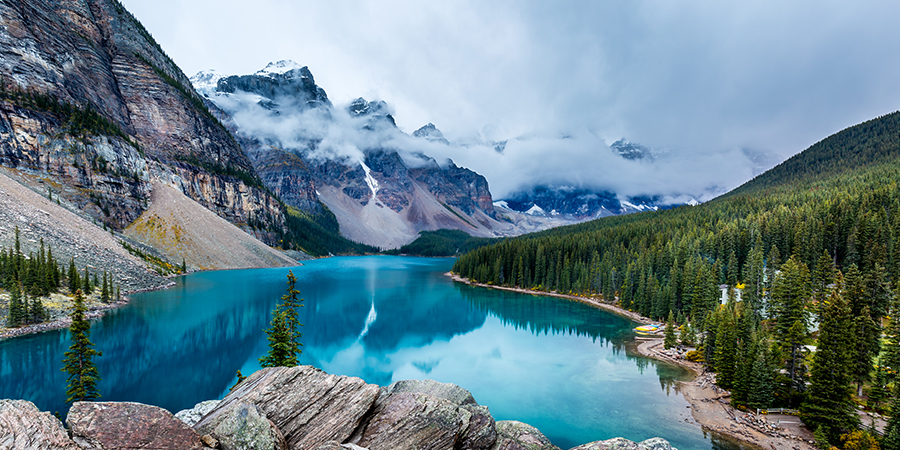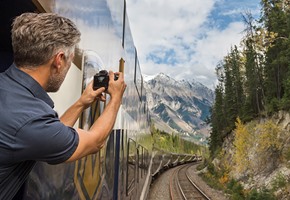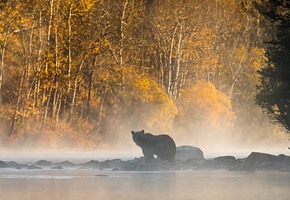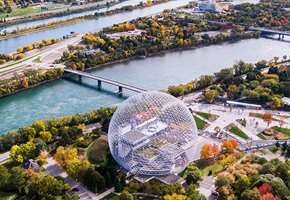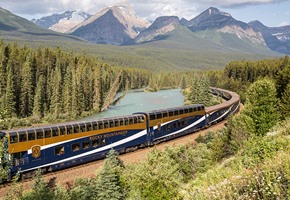Thanks to its immense size and geographical diversity, the Canadian landscape has its fair share of beautiful scenery. Nowhere, however, quite equals the jagged peaks, bright blue waters, and evergreen forests of Canada's oldest national park: Banff.
Like Glacier National Park, Banff's history is tied to the railroads. In 1883, labors on the country's first transcontinental railroad came upon a series of hot springs at Sulphur Mountain. This discovery led to the establishment of a national park. Tourists began flocking to the alpine wonderland, which had previously been populated for millennia by First Nations people.
Today, Banff remains the crown jewel of the Canadian Rockies, and has been named a UNESCO World Heritage Site. Best visited by train, the park is the perfect four season destination. Here are some of the best sights and attractions to help you plan a visit.
Must-see sights:
Lake Louise:
Lake Louise is the heart and soul of Banff National Park. Often praised as one of the most spectacular natural wonders in North America, the lake is the main hub of tourist activity. Whether you're staying at the elegant Fairmont Chateau or just passing through, you won't want to miss the breathtaking scenery at Lake Louise.
Johnston Canyon and Ink Pots:
Immerse yourself in Banff's natural beauty by taking one of the best-loved hikes in the Canadian Rockies. The Canyon is home to seven sets of waterfalls, which are all accessible via a system of catwalks. Further down the trail from the Upper Falls are a series of geothermal Ink Pots, which are enchanting blue and green mineral pools.
Sulphur Mountain:
Once you reach the perennially snowy peak, you'll be subject to some of the hands-down most spectacular alpine scenery in North America. Take in views of majestic mountains, sloping valleys, and an endless expanse of blue skies.
Moraine Lake and the Valley of the Ten Peaks:
Lake Louise's under-the-radar (and therefore less crowded) sister rivals her in beauty. Here, the placid glacial waters are a distinctive shade of blue that perfectly reflect the ten mountain peaks above. This scenery is so iconic that it is featured on the back of the Canadian twenty-dollar bill.
Peyto Lake:
This glacially fed lake is named after Bill Peyto, a former railway worker who became a mountain guide and park warden in the early days of Banff National Park. The stunning turquoise lake is best seen from a viewing platform at Bow Summit, the highest point on the Icefield Parkway.
Top activities:
Ride the Banff Gondola to the summit of Sulphur Mountain
While nature buffs may still choose to hike up lovely Sulphur Mountain, the less rugged among us can enjoy an alternate method of summiting the peak: the Banff Gondola. From the absolute safety of the gondola, you'll watch as the landscape changes before your eyes during the 8-minute ride.
Take a soak in the Upper Hot Springs
Is there a better way to enjoy mountain views than from Banff's utterly relaxing open-air hot springs? If so, we haven't found it. "Taking the waters" in Banff is a one-of-a-kind experience. The Upper Hot Springs have been developed to have all the amenities of a modern spa while retaining the therapeutic benefits of the hot springs' natural minerals, so visitors get the best of both worlds.
Visit Cave and Basin National Historic Site
Cave and Basin National Historic Site commemorates the birth of Canada's national parks system. This is where a few curious railways workers discovered the thermal springs that led to the establishment of Banff National Park. Enter the underground cavern and see for yourself where history was made.

